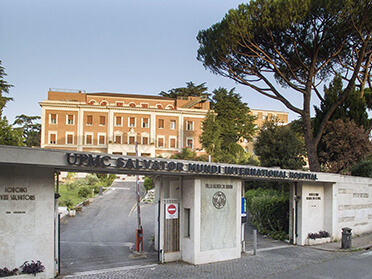Pancreas Center at UPMC Salvator Mundi International Hospital
At UPMC Salvator Mundi International Hospital, a specialist team is at the patient's service for the diagnosis and treatment of benign and malignant conditions affecting the pancreas.
UPMC's multi-disciplinary approach involves gastroenterologists, pancreatic disease specialists, endoscopists, oncologists, radiologists, and surgeons who are experts in pancreatic diseases. This helps confirm a diagnosis and establish a personalized treatment for each patient.
The UPMC SMIH pancreas team works in close collaboration with the specialists of the UPMC Hillman Cancer Center of Pittsburgh and the UPMC radiotherapy team at the UPMC Hillman Cancer Center San Pietro FBF hospital in Rome. Complex cases are discussed via videoconference with specialists, surgeons, and oncologists from UPMC's international network.
The UPMC SMIH Pancreas Center makes use not only of experienced international specialists but also of innovative minimally invasive technologies and surgical methods.
Services
- Diagnostic echo endoscopy: This is a highly complex endoscopic method, which allows visualization of the pancreas. It is designed for patients with a suspicion of or with a malignancy already diagnosed in cases of possible relapses. It is extremely useful for the evaluation of pancreatic cysts and for the distinction between benign, malignant, or potentially malignant forms.
- Interventional echoendoscope: This treats patients with pancreatic cancer and involves draining pancreatic fluids, which develop after acute pancreatitis. This also is used in primary biliary drainage or in cases of failure of endoscopic retrograde cholangiopancreatography
- Therapeutic echoendoscopy: This is used in the treatment of neuroendocrine tumors and cancer of the pancreas.
- CT exams: This treatment uses the latest generation of high-resolution multislice CT to highlight the presence of abnormal masses of tissue and the most suitable types of treatment.
- Pancreatic disease surgery: At UPMC, surgery can be used in the treatment of benign and malignant pancreatic diseases. We use minimally invasive techniques including laparoscopy and robotic surgery. Minimally invasive surgery allows for far more precision during surgery. This translates into a shorter hospital stay and a quicker recovery of the patient. The "augmented" vision uses the latest digital technology such as fluorescence-guided surgery. When injected intravenously or in the vicinity of the tumor, the fluorescent substance (indocyanine green for example) allows the visualization of anatomical structures that are less definable with the naked eye. Just think of the lymph nodes that are the site of tumor metastases. The fluorescent substance “lights up" all the lymph nodes that drain the lymph from the tumor. This innovation allows the surgeon to see exactly where the potentially metastatic lymph nodes are and to perform a very accurate lymphadenectomy, removing only the metastatic lymph nodes and thus saving healthy tissue. This reduces the duration of the surgery and the potential complications.
- Endoscopic gastroenteroanastomosis: This is a very complex procedure, performed in very few centers in Italy.
Our Doctors

We offer medical services and services on a private basis or in agreement with the main insurance companies. Some of our services are also affiliated with the National Health System.
For more information on active agreements, visit:

